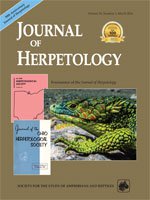Burmese Pythons (Python bivitattus) are large generalist predators that have established an expanding breeding population in Florida. As a first step in understanding current distributions, and therefore spread potential, we assessed diurnal habitat selection by Burmese Pythons in the southern Everglades using radiotelemetry. Sixteen individual pythons were radio-tracked between September 2006 and December 2009. Habitat variables included land cover, habitat edges, surface water depth, and change in water depth. Python locations were compared to available habitat, both within each snake's home range and across the entire study area, by calculating selection ratio intervals and developing resource selection functions. Habitat selection by Burmese Pythons in south Florida was nonrandom with clear selection of broad-leafed and coniferous forest and avoidance of open water and other habitats with deep water. We concluded that Burmese Pythons selected habitats with a substantial canopy overstory that was without deep flooding, with no strong selection for freshwater emergent macrophyte marsh habitats that dominate (∼ 43%) the study area. We will use these new quantitative insights into python habitat selection to model the potential for this invasive species to expand to new areas within Florida.
How to translate text using browser tools
1 March 2016
Habitat Selection by the Invasive Species Burmese Python in Southern Florida
Theresa M. Walters,
Frank J. Mazzotti,
H. Carl Fitz
ACCESS THE FULL ARTICLE

Journal of Herpetology
Vol. 50 • No. 1
March 2016
Vol. 50 • No. 1
March 2016




